History of Acoustic Impedance Measurement
At the 2013 Audiology Now meeting in Anaheim, a group of us (Robert Margolis, Charles Berlin, Jay Hall III, and myself, were invited to present on the History of Audiology (hearing testing, hearing aids, and vestibular testing). That which follows is a second part of the presentation on the “History of Audiology” and which takes on the format of trivia questions, utilizing materials from the session on “History of Acoustic Immittance Measurements” presented by Robert H. Margolis, Ph.D.
Wayne Staab, Section Editor
TEST YOUR KNOWLEDGE – ACOUSTIC IMMITTANCE MEASUREMENT
By Robert H. Margolis. PhD
- Name the individual who found that after pressurizing the middle ear, that “the ear becomes insensible to grave tones,” in 1820?
- An early contributor wrote “Experiments in Audition” in 1927, in which he reported that ear canal air pressure showed decreased sensitivity to low frequency sounds. Who was this person? However, he was probably better remembered for another significant contribution that is used commonly in hearing research and development.
- The word “impedance” was coined by this person, who wrote: “Let us call the ratio of the impressed force to the current…the impedance of the line, from the verb impede… (Put the accent on the middle e in impedance.)” Who was that person?
- A couple of telephone engineers played an important role by writing about acoustical impedance in both theory and human measurements. Is there any chance you can name two of them?
- Who was the Nobel Prize recipient who measured the acoustic impedance of the ear with varying ear canal air pressures?
- What is this person doing, where, and who is he (person in white)?

- Who first used the term “tympanometry” to describe the effect of ear canal pressure on impedance?
- What is this person holding, and who is he?
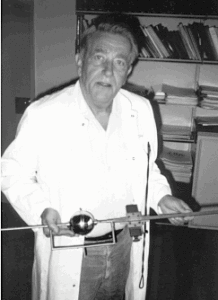
- Who introduced the concept of classifying tympanometric shapes?
- The first large clinical validation study of 226-Hz tympanometry was reported by?
- What was the “Vanhuyse Model?”
- Acoustic reflectance/absorbance was initially reported by?
ANSWERS
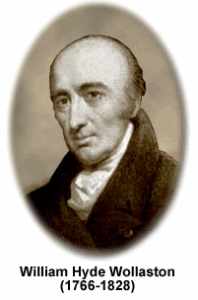 William Hyde Wollaston (1766-1828). Read “On Sounds Inaudible by Certain Ears” at the <em, June 29, 1820. He was an English chemist and physicist made famous by discovering two chemical element, and also developed a way to process platinum ore into malleable ingots. In addition to his chemical work, he made significant contributions to the fields of botany, mechanics, electrochemistry, astronomy, crystallography, physiology, optics, and scientific instrumentation. In 1820 he reported the inability of most humans to hear the high-pitched notes of bats and insets, and in 1924, while investigating the possible physiological basis for his own recurring visual problems (now known as hemianopia), he deduced the correct anatomical arrangement of human optic nerves.
William Hyde Wollaston (1766-1828). Read “On Sounds Inaudible by Certain Ears” at the <em, June 29, 1820. He was an English chemist and physicist made famous by discovering two chemical element, and also developed a way to process platinum ore into malleable ingots. In addition to his chemical work, he made significant contributions to the fields of botany, mechanics, electrochemistry, astronomy, crystallography, physiology, optics, and scientific instrumentation. In 1820 he reported the inability of most humans to hear the high-pitched notes of bats and insets, and in 1924, while investigating the possible physiological basis for his own recurring visual problems (now known as hemianopia), he deduced the correct anatomical arrangement of human optic nerves.-
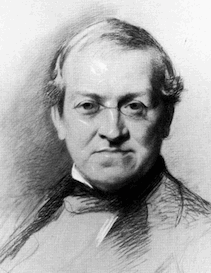 Sir Charles Wheatstone (1802-1875) wrote about this in “Experiments on Audition” in the Quarterly Journal of Science, Literature, and Art, in 1927. He reported as well on the occlusion effect, the binaural stethoscope (invention attributed to Nicholas Comins in 1929), beats, aural distortion (2f1-f2), ear canal air pressure decreasing sensitivity to low frequency sounds, and that high frequency sounds were attenuated by middle ear pressure. He was an English scientist and inventor of many scientific breakthroughs of the Victorian era, including the English concertina, the stereoscope (device for displaying three-dimensional images), and the Playfair cipher (encryption technique). However, he is best known for his contributions to the development of the Wheatstone bridge, originally invented by Samuel Hunter Christie, which is used to measure an unknown electrical resistance, and as a major figure in the development of telegraphy.
Sir Charles Wheatstone (1802-1875) wrote about this in “Experiments on Audition” in the Quarterly Journal of Science, Literature, and Art, in 1927. He reported as well on the occlusion effect, the binaural stethoscope (invention attributed to Nicholas Comins in 1929), beats, aural distortion (2f1-f2), ear canal air pressure decreasing sensitivity to low frequency sounds, and that high frequency sounds were attenuated by middle ear pressure. He was an English scientist and inventor of many scientific breakthroughs of the Victorian era, including the English concertina, the stereoscope (device for displaying three-dimensional images), and the Playfair cipher (encryption technique). However, he is best known for his contributions to the development of the Wheatstone bridge, originally invented by Samuel Hunter Christie, which is used to measure an unknown electrical resistance, and as a major figure in the development of telegraphy. 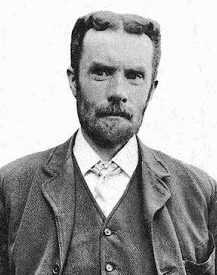 Oliver Heaviside (1850-1925). Heaviside published hundreds of papers in The Electrician. He rewrote Maxwell’s equations on electrodynamics, wrote on vector mathematics, the age of the ear, improved the lightening rod, and developed long transmission telegraph lines. In addition to coining the term “impedance,” he wrote defining equations in “Electromagnetic induction and its propagation,” Section XXIX, The Electrician, 1996, the reference for his defining the word “impedance.” Heaviside suffered from hearing loss. Heaviside was a self-taught electrical engineer, mathematician, and physicist who adapted complex numbers to the study of electrical circuits, invented mathematical techniques to the solution of differential equations, reformulated Maxwell’s field equations in terms of electric and magnetic forces and energy flux, and independently co-formulated vector analysis. Although at odds with the scientific establishment for most of his life, Heaviside changed the face of mathematics and science for years to come.
Oliver Heaviside (1850-1925). Heaviside published hundreds of papers in The Electrician. He rewrote Maxwell’s equations on electrodynamics, wrote on vector mathematics, the age of the ear, improved the lightening rod, and developed long transmission telegraph lines. In addition to coining the term “impedance,” he wrote defining equations in “Electromagnetic induction and its propagation,” Section XXIX, The Electrician, 1996, the reference for his defining the word “impedance.” Heaviside suffered from hearing loss. Heaviside was a self-taught electrical engineer, mathematician, and physicist who adapted complex numbers to the study of electrical circuits, invented mathematical techniques to the solution of differential equations, reformulated Maxwell’s field equations in terms of electric and magnetic forces and energy flux, and independently co-formulated vector analysis. Although at odds with the scientific establishment for most of his life, Heaviside changed the face of mathematics and science for years to come.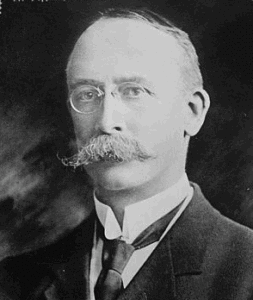 Arthur Gordon Webster (1863-1923). Webster wrote about “Acoustical impedance, and the theory of horns and the phonograph,” in the Proceedings of the National Academy of Science (U.S.A.), 5, 275-282, 1919. He founded the American Physical Society. His work was in the field of acoustics and mechanics. He is credited with developing an instrument to measure the absolute intensity of sound, the phonometer, and for research on the gyroscope. W. West wrote on “Measurements of the acoustical impedances of human ears,” Post Office Electrical Engineers Journal, 21, 293-300, 1928.
Arthur Gordon Webster (1863-1923). Webster wrote about “Acoustical impedance, and the theory of horns and the phonograph,” in the Proceedings of the National Academy of Science (U.S.A.), 5, 275-282, 1919. He founded the American Physical Society. His work was in the field of acoustics and mechanics. He is credited with developing an instrument to measure the absolute intensity of sound, the phonometer, and for research on the gyroscope. W. West wrote on “Measurements of the acoustical impedances of human ears,” Post Office Electrical Engineers Journal, 21, 293-300, 1928.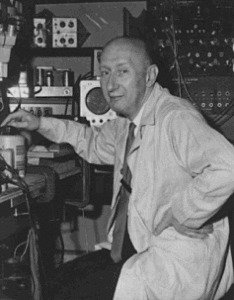 Georg von Békésy (1899-1972) was a Hungarian biophysicist born in Budapest, Hungary. In 1961, he was awarded the Nobel Prize in Physiology or Medicine for his research on the function of the cochlea in the mammalian hearing organ. Interestingly, von Békésy never published a statistical study, conducting much of his work on a single subject – himself.
Georg von Békésy (1899-1972) was a Hungarian biophysicist born in Budapest, Hungary. In 1961, he was awarded the Nobel Prize in Physiology or Medicine for his research on the function of the cochlea in the mammalian hearing organ. Interestingly, von Békésy never published a statistical study, conducting much of his work on a single subject – himself.- The person is Otto Metz at the Rigshospitalet in Copenhagen, Denmark, 1952. He is making an impedance measurement.
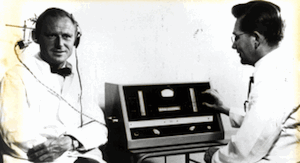 Knut Terkildsen, in 1964 was the first to use the term “tympanometry” to describe the effect of ear canal pressure on impedance. “Clinical application of impedance measurements with a fixed frequency technique,” International Audiology 3, 147-155, 1964. He is shown here having impedance measurements made with Scott-Nielsen (about 1958).
Knut Terkildsen, in 1964 was the first to use the term “tympanometry” to describe the effect of ear canal pressure on impedance. “Clinical application of impedance measurements with a fixed frequency technique,” International Audiology 3, 147-155, 1964. He is shown here having impedance measurements made with Scott-Nielsen (about 1958).- The item being held is the Metz Bridge (1981), and the person holding it is Knut Terkildsen.
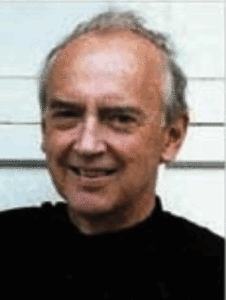 Gunnar Lidén, M.D., Ph.D., Gothenburg, Sweden, introduced the concept of classifying tympanometric shapes in 1969, writing in The Journal of Laryngology and Otology, June 1969, “The scope and application of current audiometric tests”. The original shapes and associated hearing conditions are shown in the accompanying photo. Lidén had a profound influence on the development of audiology in Scandinavia. He introduced speech audiometry to Sweden in the mid-1950s and was a pioneer in the area of impedance measurements, having published on the significance of the stapedial reflex for speech understanding in 1963.
Gunnar Lidén, M.D., Ph.D., Gothenburg, Sweden, introduced the concept of classifying tympanometric shapes in 1969, writing in The Journal of Laryngology and Otology, June 1969, “The scope and application of current audiometric tests”. The original shapes and associated hearing conditions are shown in the accompanying photo. Lidén had a profound influence on the development of audiology in Scandinavia. He introduced speech audiometry to Sweden in the mid-1950s and was a pioneer in the area of impedance measurements, having published on the significance of the stapedial reflex for speech understanding in 1963.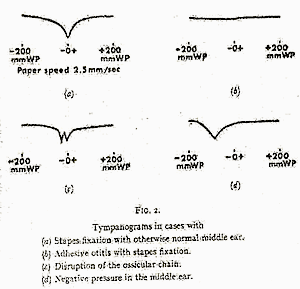
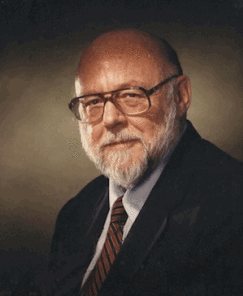 James Jerger, Ph.D., 1970. In this article, Jerger modifies Lidén’s classification system, and comments about the significance of impedance audiometry saying: “In our experience, impedance audiometry represents an invaluable diagnostic tool in clinical audiometry. … We frankly wonder how we ever got along without it.” The paper reported on clinical experience using an electroacoustical bridge to access the efficacy of the electroacoustic approach as a routine clinical procedure and to evaluate its diagnostic value in a typical audiologic caseload. Jerger, J. “Clinical experience with impedance audiometry,” Arch. Otolaryng. Vol. 92, Oct. 1976.
James Jerger, Ph.D., 1970. In this article, Jerger modifies Lidén’s classification system, and comments about the significance of impedance audiometry saying: “In our experience, impedance audiometry represents an invaluable diagnostic tool in clinical audiometry. … We frankly wonder how we ever got along without it.” The paper reported on clinical experience using an electroacoustical bridge to access the efficacy of the electroacoustic approach as a routine clinical procedure and to evaluate its diagnostic value in a typical audiologic caseload. Jerger, J. “Clinical experience with impedance audiometry,” Arch. Otolaryng. Vol. 92, Oct. 1976.- Scandinavian Audiology, 4:45-50, 1975. “On the W-notching of tympanograms. V.J. Vanhuyse, W.L. Creten, and K.J. van Camp, from the Physical Laboratory, University Centre of Antwerp, Antwerp, Belgium. These authors reported that the so-called W-notching of tympanograms could be explained if some realistic assumptions are accepted about the dependence on the pressure in the external auditory meatus of the acoustical resistance and the acoustical reactance at the eardrum. Sets of susceptance and conductance tympanograms can be classified in four groups according as the pairs of tympanograms show, respectively, 1 and 1, 3 and 1, 3 and 3, or 5 and 3 externa. The appearance of a W-pattern in the admittance proves that for a certain p interval, the ear becomes mass controlled. The theory also shows that for higher frequency probe tones no pathology is necessary to explain W-notching.
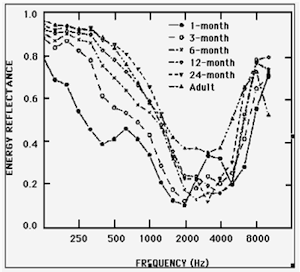 M.R. Stinson, E.A.G. Shaw, and B. W. Lawton published an article describing acoustic reflectance/absorbance in 1982. The article was “Estimation of acoustical energy reflectance at the eardrum from measurements of pressure distribution in the human ear canal. This was published in the Journal of the Acoustical Society of America, 72, 766 (1982). This was followed up in 1993 with another article titled “Acoustic Reflectance/Absorbance,” D.H. Keefe, J.D. Bulen, K.H. Arehart, and E.M. Burns, (1993). Journal of the Acoustical Society of America, 94, 2617-38. This article showed the acoustic reflectance/absorbance in subjects ranging in age from 1 month through adulthood.
M.R. Stinson, E.A.G. Shaw, and B. W. Lawton published an article describing acoustic reflectance/absorbance in 1982. The article was “Estimation of acoustical energy reflectance at the eardrum from measurements of pressure distribution in the human ear canal. This was published in the Journal of the Acoustical Society of America, 72, 766 (1982). This was followed up in 1993 with another article titled “Acoustic Reflectance/Absorbance,” D.H. Keefe, J.D. Bulen, K.H. Arehart, and E.M. Burns, (1993). Journal of the Acoustical Society of America, 94, 2617-38. This article showed the acoustic reflectance/absorbance in subjects ranging in age from 1 month through adulthood.
This article is reprinted with permission of the Editor of HHTM.

